2019 MERCEDES-BENZ CLA COUPE ECU
[x] Cancel search: ECUPage 51 of 330

passenger
frontair bag isenabled ordisa-
bled inaccor dance withtheperson inthe
fron t-passenger seat
R the fron t-passenger seathasbeen moved
back asfar back aspossible.
R the person isseated correctly.
Make sure,bothbefore andduring thejour-
ney, thatthestatusofthe fron t-passenger
fron tair bag iscorr ect. G
WARN
ING
If you secure achild inarearward-f acingchild
rest raint system onthe fron t-passenger seat
and thePAS SENGER AIRBAGOFF indicat or
lamp isoff, thefron t-passenger frontair bag
can deploy inthe event ofan acciden t.The
child could bestruck bythe airbag. Thisposes
an incr eased riskofinjury oreven fatalinjury.
Make surethatthefron t-passenger frontair
bag hasbeen deactiv ated.ThePASSENGER
AIR BAGOFF indicat orlamp must belit.
NEV ERuse arearward-f acingchildrestraint
on aseat prote cted byan ACTIVE FRONTAIR-
BA Gin fron tof it;DE ATH orSERIOUS INJURY
to the child canoccur.
If the PAS SENGER AIRBAGOFF indicat orlamp
stays off,donot installarearward-f acingchild
rest raint system onthe fron t-passenger seat.
You canfind more information onOCS under
"Problems withtheOcc upant Classification Sys-
tem" (Ypage 51). G
WARN
ING
If you secure achild inaforward- facingchild
rest raint system onthe fron t-passenger seat
and youposition thefron t-passenger seattoo
close tothe dashboard, inthe event ofan
acciden t,the child could:
R come intocon tact with thevehicle's inte-
rior ifthe PAS SENGER AIRBAGOFF indi-
cator lampislit, for example
R be struck bythe airbag ifthe PAS SENGER
AIR BAGOFF indicat orlamp isoff
This poses anincr eased riskofinjury oreven
fatal injury. Always
movethefron t-passenger seatasfar
back aspossible andfully retract the seat
cushion length.Always makesurethatthe
shoulder beltstrap iscorr ectlyrouted from
the vehicle beltsash guide tothe shoulder
belt guide onthe child restraint system. The
shoulder beltstrap must berouted forwards
and downwards fromthevehicle beltsash
guide. Ifnec essary, adjustthevehicle belt
sash guide andthefron t-passenger seat
accor dingly. Always observe thechild
rest raint system manufact urer'sinstallation
inst ruct ions.
If OCS determ inesthat:
R The front-passenger seatisunocc upied, the
PAS SENGER AIRBAGOFF indicat orlamp
lights upafter thesystem self-testand
remains lit.This indicat esthat thefron t-
passenger frontair bag isdeactiv ated.
R The front-passenger seatisocc upied bya
child ofup totwelve monthsold, inastan dard
child restraint system, thePAS SENGER AIR
BA GOFF indicat orlamp lights upafter the
system self-testand remains lit.This indi-
cates thatthefron t-passenger frontair bag is
deactiv ated.
But even inthe case ofatwelve- month-old
child, inastan dard child restraint system, the
PAS SENGER AIRBAGOFF indicat orlamp can
go out after thesystem self-test.This indi-
cates thatthefron t-passenger frontair bag is
activ ated. Theresult ofthe classific ationis
dependen ton, among otherfactors, thechild
rest raint system andthechild's stature. Itis
recom mended thatyouinstallthe child
rest raint system onasuitable rearseat.
R The front-passenger seatisocc upied bya
person ofsmaller stature (e.g. ateen ager or
small adult), thePAS SENGER AIRBAGOFF
indicat orlamp lights upand remains litafter
the system self-testdependin gon the result
of the classific ationor,altern atively, goesout.
- Ifthe PAS SENGER AIRBAGOFF indicat or
lamp isoff, move thefron t-passenger seat Occupant
safety
49Safet y Z
Page 56 of 330
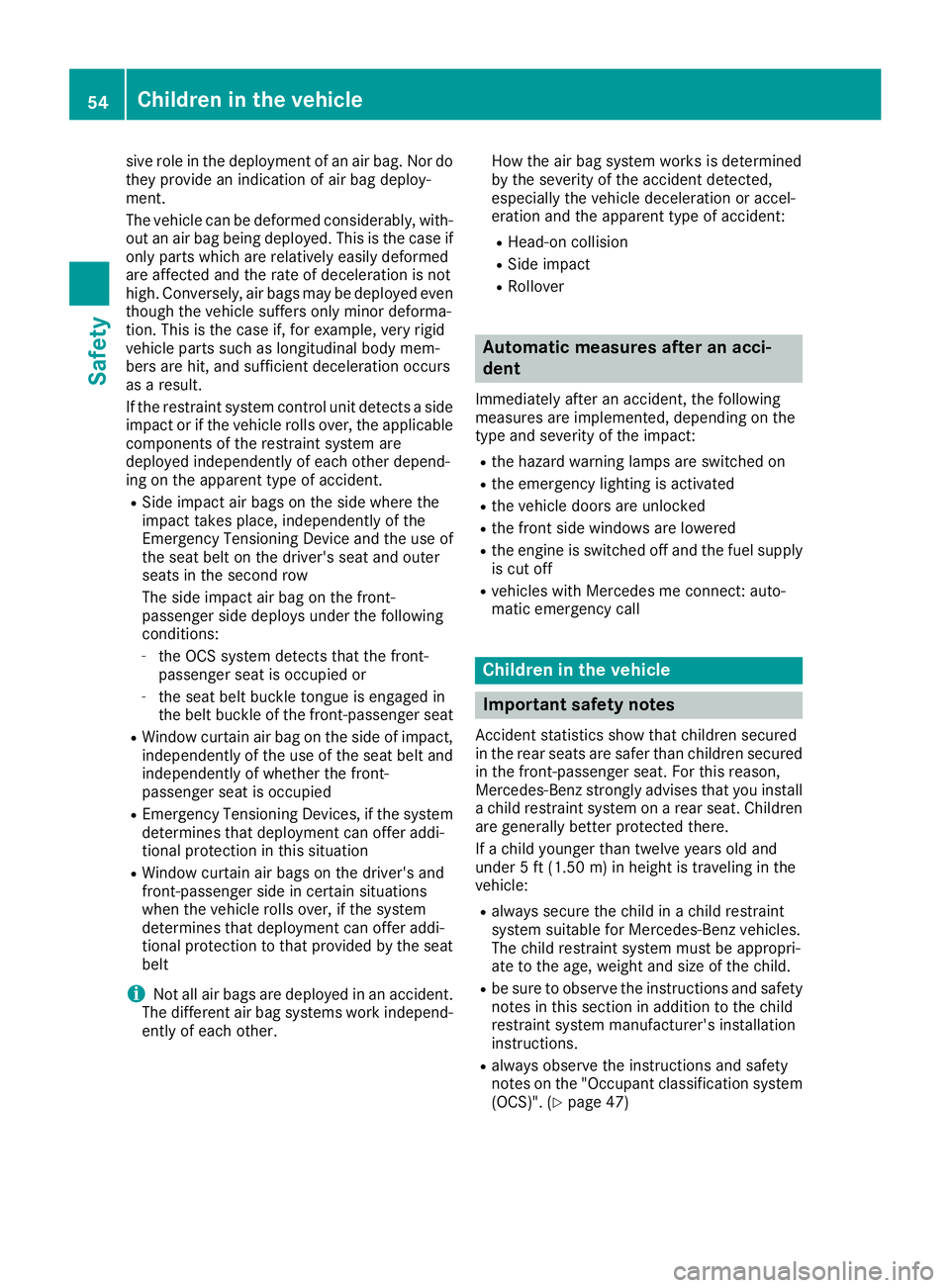
sive
roleinthe deploy mentofan air bag. Nordo
they provide anindication ofair bag deploy -
ment.
The vehicle canbedeformed considerably, with-
out anair bag being deploy ed.This isthe case if
only parts which arerelatively easilydeformed
are affected andtherate ofdeceleration isnot
high. Conversely, airbags maybedeploy edeven
though thevehicle suffersonlyminor deforma-
tion. Thisisthe case if,for example, veryrigid
vehicle partssuchaslongitudinal bodymem-
bers arehit,and sufficient deceleration occurs
as aresult.
If the restraint systemcontrolunit detects aside
impact orifthe vehicle rollsover, theappli cable
component sof the restraint systemare
deploy edindependently ofeach other depend-
ing onthe appa renttype ofaccident.
R Side impact airbags onthe side where the
impact takesplace, independently ofthe
Emergenc yTensioning Deviceandtheuse of
the seat beltonthe driver's seatandouter
seats inthe second row
The side impact airbag onthe front -
passenger sidedeploy sunder thefollowi ng
conditions:
- the OCS system detects thatthefront -
passenger seatisoccupied or
- the seat beltbuckle tongue isengaged in
the belt buckle ofthe front -passenger seat
R Window curtainairbag onthe side ofimpact,
independently ofthe use ofthe seat beltand
independently ofwhether thefront -
passenger seatisoccupied
R Emergenc yTensioning Devices,ifthe system
determines thatdeploy mentcanoffer addi-
tional protection inthis situation
R Window curtainairbags onthe driver's and
front -passenger sideincertain situations
when thevehicle rollsover, ifthe system
determines thatdeploy mentcanoffer addi-
tional protection tothat provided bythe seat
belt
i Not
allair bags aredeploy edinan accident.
The different airbag systems workindepend-
ently ofeach other. How
theairbag system worksisdetermined
by the severity ofthe accident detected,
especial lythe vehicle deceleration oraccel-
eration andtheappa renttype ofaccident:
R Head-on collision
R Side impact
R Roll over Automatic
measuresafteranacci-
dent
Immediately afteranaccident, thefollowi ng
measures areimplemented, dependingonthe
type andseverity ofthe impact:
R the hazard warning lampsareswitched on
R the emergency lightingisactivated
R the vehicle doorsareunlocked
R the front sidewindows arelowered
R the engine isswitched offand thefuel supply
is cut off
R vehicles withMercedes meconn ect:auto-
matic emergency call Children
inthe vehicl e Importa
ntsafety notes
Acc ident statistics showthatchildren secured
in the rear seats aresafer thanchildren secured
in the front -passenger seat.Forthis reason,
Mercedes-Benz stronglyadvisesthatyouinstall
a child restraint systemonarear seat. Children
are generally betterprotected there.
If achild younger thantwelve yearsoldand
under 5ft (1.50 m)inheight istraveling inthe
vehicle:
R alwa yssecure thechild inachild restraint
system suitable forMercedes-Benz vehicles.
The child restraint systemmustbeappropri-
ate tothe age, weight andsize ofthe child.
R be sure toobserve theinstruct ionsandsafety
notes inthis section inaddition tothe child
restraint systemmanufacturer's installation
instruct ions.
R alwa ysobserve theinstruct ionsandsafety
notes onthe "Occupant classification system
(OCS)". (Ypage 47) 54
Children
inthe vehicl eSafety
Page 57 of 330

G
WARNING
If you leavechild renunsu pervi sedinthe vehi-
cle, they couldset itin motion by,forexampl e:
R rele ase theparki ngbrake.
R shift theautomatic transmissi onout ofthe
parki ngposi tion P.
R start theengine.
In add ition, theymayopera tevehicl eequ ip-
ment andbecome trapped.There isarisk of
an accide ntand injury .
When leaving thevehicl e,alw aystake the
SmartKey withyouand lock thevehicl e.Never
lea vechild renunsu pervi sedinthe vehicl e. G
WARNING
If perso ns,particu larlychild renaresubjected
to prolo nged exposu reto extreme heator
cold, there isarisk ofinjury ,possi blyeven
fatal .Never leavechild renunattended inthe
vehicl e. G
WARNING
If the child restrai ntsystem issub jected to
dire ctsunli ght,parts maygetvery hot.Chil-
dren mayburn themsel vesonthese parts,
particu larlyon the metal partsofthe child
restrai ntsystem. Thereisarisk ofinjury .
If you leavethe vehicl e,taking thechild with
you ,alw aysensure thatthechild restrai nt
system isnot expose dto dire ctsunli ght.Pro-
tect itwith abla nket, forexampl e.Ifthe child
restrai ntsystem hasbeen expose dto dire ct
sunli ght,letitcool downbefore securingthe
child init. Never leavechild renunattended in
the vehicl e.
Alwa ysensure thatallvehicl eoccupa ntshave
their seatbeltsfastened correctly andaresitting
prope rly.Particu larattention mustbepaidto
child ren.
Observe thesafety notesonthe seat belt
(Y pag e42) and thenotes oncorrect useofseat
bel ts(Y pag e43).
A booster seatmaybenecessa ryto achie ve
prope rseat beltposi tioning forchild renover
40 lbs (18 kg)until theyreach aheig htwhere athree-poi
ntseat beltcan beprope rlyfastened
witho utabooster seat. Spec
ialseatbe ltretractor G
WARNING
If the seat beltis rele ased whiledrivi ng,the
child restrai ntsystem willno longer be
secure dprope rly.The speci alseat beltretrac-
tor isdisa bledand theinertia realdraw sin a
portion ofthe seat belt.The seat beltcannot
be immed iatelyrefastene d.There isan
increas edrisk ofinjury ,possi blyeven fatal.
Stop thevehicl eimmed iately,pay ing atten-
tion toroad andtraffic conditions. Reactivate
the speci alseat beltretractor andsecure the
child restrai ntsystem properly.
All seat beltsinthe vehicl e,except thedrive r's
seat belt,are equipped with aspeci alseat belt
retractor. Whenactivated,thespeci alseat belt
retractor ensuresthat theseat beltcannot
sla cken once thechild seatissecure d.
Install ingachild restrai ntsystem:
X Make sureyouobser vethe child restrai nt
system manufacturer's installationinstruc-
tions.
X Pul lthe seat beltsmoothly fromthebeltout-
let.
X Engage seatbelttongue inbel tbuckle .
Activating thespeci alseat beltretractor:
X Pul lthe seat beltout fullyand letthe inertia
reel retract itaga in.
Whil ethe seat beltis retracting, youshou ld
hear aratcheting sound.The speci alseat belt
retractor isenabl ed.
X Push thechild restrai ntsystem downso that
the seat beltis tight anddoes notloos en.
Remo vingthechild restrai ntsystem anddeac-
tivating thespeci alseat beltretractor:
X Make sureyouobser vethe child restrai nt
system manufacturer's installationinstruc-
tions.
X Press therelease button ofthe seat belt
buckle andguide the seat belttongue back
toward sthe beltsash guide.
The speci alseat beltretractor isdea ctivated. Chi
ldren inthe vehi cle
55Safety Z
Page 58 of 330
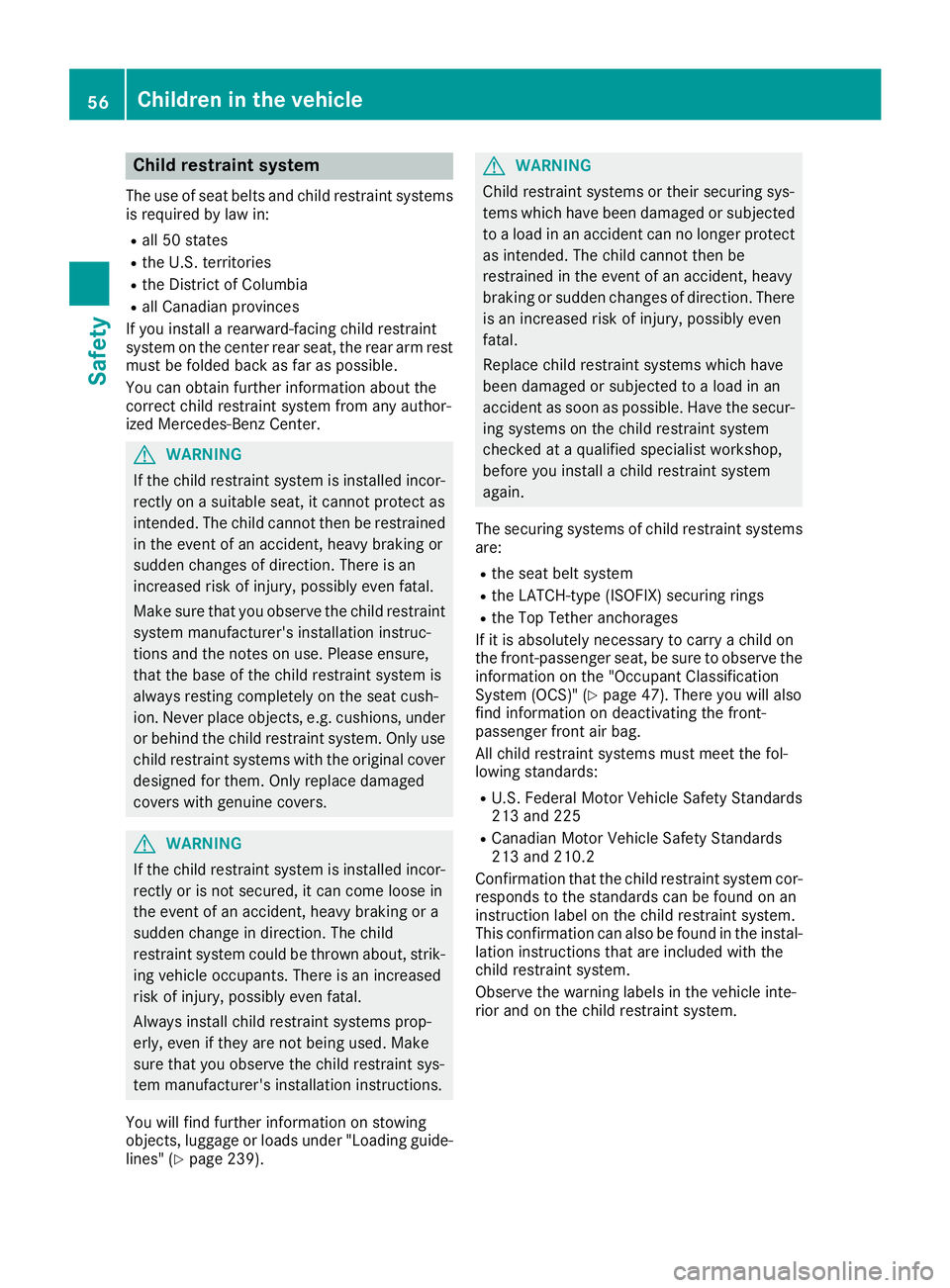
Child
restraint system
The useofseat beltsand child res traint systems
is requi redbylaw in:
R all 50 state s
R theU. S. territo ries
R theDis trict ofColumb ia
R all Canad ianprovinces
If you install arear ward- facing child res traint
syst emonthecen terrear seat,th erear armrest
must befold edback asfar asposs ible.
You canobtain further inform ationabout the
cor rectch ild res traint systemfrom any auth or-
ize dMer cedes-Ben zCen ter. G
WAR
NING
If th ech ild res traint systemisins tall edincor-
rec tlyon asuit able seat,it can notpro tect as
int ended. Thechild can notth en be res traine d
in theeve ntofan acc iden t,heav ybrak ingor
sudde nch ang esofdire ction .Ther eis an
inc reas edriskof injury, poss iblyevenfat al.
Mak esure that you obse rveth ech ild res traint
syst emman ufacturer'sins tall atio nins truc-
tio ns and theno teson use. Pleas een sure ,
th at thebase ofthech ild res traint systemis
always restingcom pletelyontheseat cush-
ion .Nev erplac eobj ect s,e.g .cus hion s,unde r
or behin dth ech ild res traint system. Onlyuse
ch ild res traint systems withth eorig inal cover
desig nedfor them. Onlyrepl ace damag ed
cov ers withgen uine covers. G
WAR
NING
If th ech ild res traint systemisins tall edincor-
rec tlyorisno tsec ured, itcan com eloos ein
th eeve ntofan acc iden t,heav ybrak ingora
sudde nch ang ein dire ction .The child
res traint systemcoul dbe thrown about ,st rik -
ing vehicle occupant s.Ther eis an increas ed
ris kof injury, poss iblyevenfat al.
Always install child res traint systems prop-
erly, evenif th ey are notbein gused. Make
sure that you obse rveth ech ild res traint sys-
te m man ufacturer'sins tall atio nins truct ions.
You willfindfur ther inform ationon stowin g
obj ect s,luggag eor loads under"Load ingguide-
lin es" (Ypage 239). G
WAR
NING
Child restraint systems ortheir sec urin gsys-
te ms whic hhave been damag edorsubj ected
to aload inan acc iden tcan nolon ger protect
as intended. Thechild can notth en be
res traine din theeve ntofan acc iden t,heav y
brak ingorsudde nch ang esofdire ction .Ther e
is an increas edriskof injury, poss iblyeven
fat al.
Replac ech ild res traint systems whichhave
been damag edorsubj ectedtoaload inan
acc iden tas soon asposs ible. Haveth esec ur-
ing syst ems onthech ild res traint system
ch eck edataqualif iedspec ialist workshop,
bef ore you install ach ild res traint system
again .
The securin gsyst ems ofchild res traint systems
are:
R theseat beltsystem
R theLA TCH- type (ISOF IX) sec urin grin gs
R theTop Tether anchorages
If it is absol utelyne ces sary tocar ryach ild on
th efron t-pass enger seat ,be sure toobse rveth e
inf orm ationon the"Oc cupan tClassi ficatio n
Sys tem (OCS )"(Y page 47).Ther eyou willalso
fin dinf orm ationon deac tivatin gth efron t-
pass enger fron tair bag.
All child res traint systems must meetth efol-
lowin gst and ards :
R U.S. Fed eral MotorVeh icle SafetySt and ards
21 3and 225
R Canad ianMot orVeh icle SafetySt and ards
21 3and 210.2
Con firmat ionthat thech ild res traint systemcor-
res pon dstothest and ards canbefoun don an
ins truct ion label onthech ild res traint system.
This confirmat ioncan also befoun din theins tal-
lati on instruct ionsth at are included withth e
ch ild res traint system.
Obse rveth ewarn inglabels intheveh icle inte-
rior and onthech ild res traint system. 56
Child
reninthevehi cleSafety
Page 59 of 330
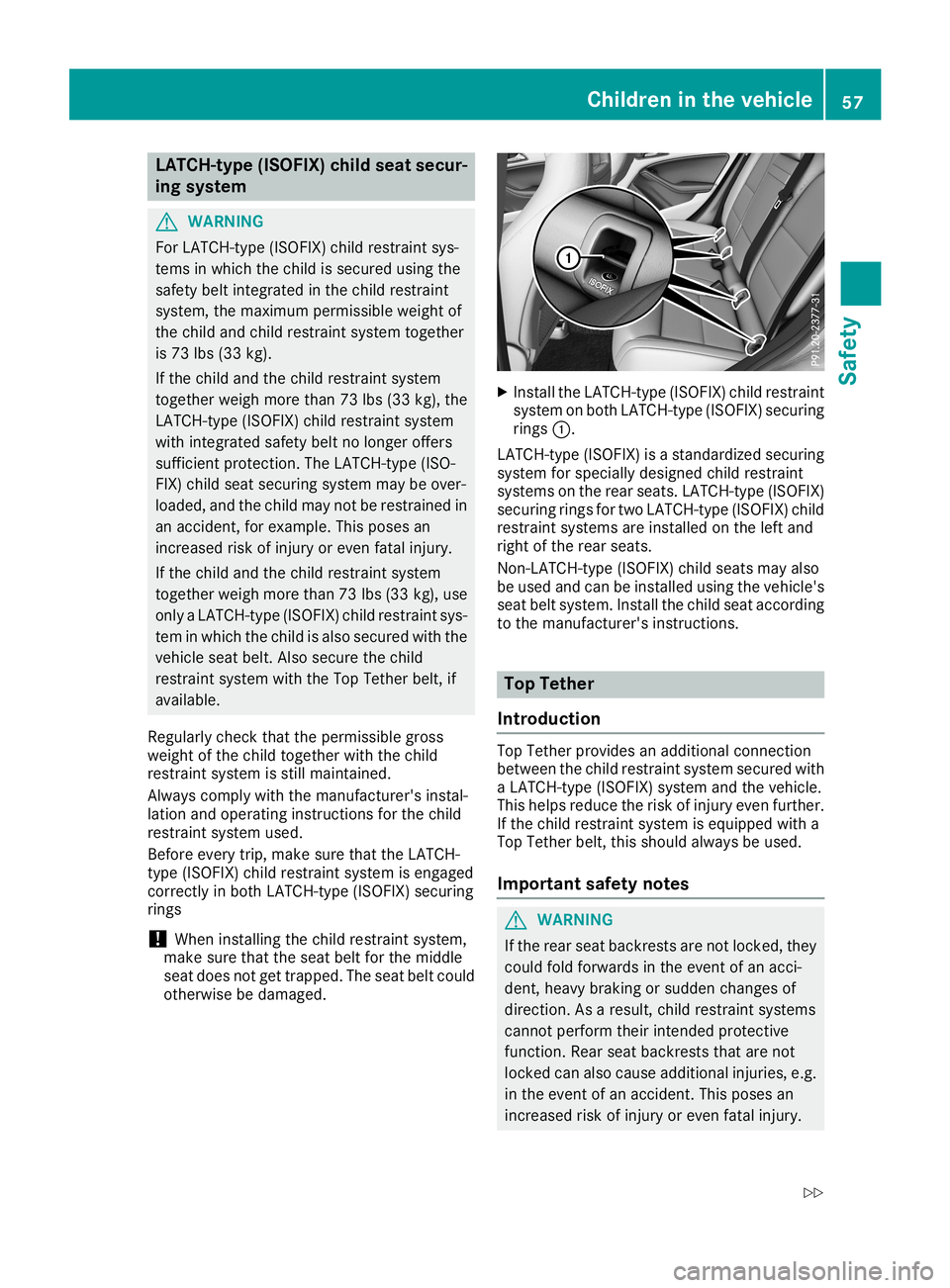
LATCH
-typ e(ISOFIX) childseatsecur -
ing syst em G
WAR
NING
For LATCH- type (ISOFI X)chi ldres traint sys-
tem sin whic hth echi ldissec ured usingth e
safe tybelt integrat edinthechi ldres traint
syst em, themax imum permissibleweight of
th echi ldand childres traint systemtoget her
is 73 lbs (33 kg).
If th echi ldand thechi ldres traint system
to get her weigh moreth an 73 lbs (33 kg), the
LA TCH- type (ISOFI X)chi ldres traint system
with integrat edsafe tybelt nolonger offers
suff icientprot ection.The LATCH- type (ISO-
FI X) chi ldseat securin gsyst emmay beover -
loaded, andthechi ldmay notberes trained in
an acc iden t,for exam ple.This poses an
inc reas edrisk ofinjury oreven fatalinj ury.
If th echi ldand thechi ldres traint system
to get her weigh moreth an 73 lbs (33 kg),use
on lyaLA TCH- type(IS OF IX) child res traint sys-
te m inwhic hth ech ild isalso secured withth e
veh icle seat belt.Als osec ure thech ild
res traint systemwithth eTop Tether belt,if
availab le.
Regular lych eck that theper mis sible gross
weigh tof thech ild toget her withth ech ild
res traint systemisstill main tained.
Alwa yscomply withth eman ufacturer'sins tal-
lati on and oper atingins truct ionsfor thech ild
res traint systemused.
Bef ore everytrip, mak esure that theLA TCH-
typ e(IS OF IX) child res traint systemisen gaged
co rrect lyin bot hLA TCH- type(IS OF IX) sec urin g
rin gs
! When
install ing thech ild res traint system,
mak esure that theseat beltforthemidd le
seat does notget trapped. Theseat beltcould
ot her wise bedamag ed. X
Inst all theLA TCH- type(IS OF IX) child res traint
syst emonbot hLA TCH- type(IS OF IX) sec urin g
rin gs 0043.
LA TCH- type(IS OF IX) isast and ardiz edsec urin g
syst emforspec iallydesig nedch ild res traint
syst ems ontherear seats.LA TCH- type(IS OF IX)
sec urin grin gs for two LATCH- type(IS OF IX) child
res traint systems areinstall ed on theleft and
righ tof therear seats.
Non -LAT CH- type(IS OF IX) child seat smay also
be used andcanbeinstall edusin gth eveh icle's
seat beltsystem. Inst all thech ild seat according
to theman ufacturer'sins truct ions. Top
Tether
Int rod uction Top
Tether provide san addit ionalco nn ect ion
bet ween thech ild res traint systemsecured with
a LA TCH- type (ISOF IX) syst emand theveh icle.
This helps reduce theris kof injury evenfur ther.
If th ech ild res traint systemisequipp edwitha
Top Tether belt,th is sho uld always beused.
Imp ortant safety notes G
WAR
NING
If th erear seat back restsare notloc ked,they
co uld fold forwards intheeve ntofan acc i-
den t,heav ybrak ingorsudde nch ang esof
dire ction .As ares ult, child res traint systems
can notper formtheir intended protective
fun ction .Rear seatbackreststhat are not
loc kedcan also caus eaddit ionalinj uries ,e.g .
in theeve ntofan acc iden t.This pose san
inc reas edriskof injury oreve nfat alinj ury. Child
reninthevehi cle
57Safety
Z
Page 60 of 330
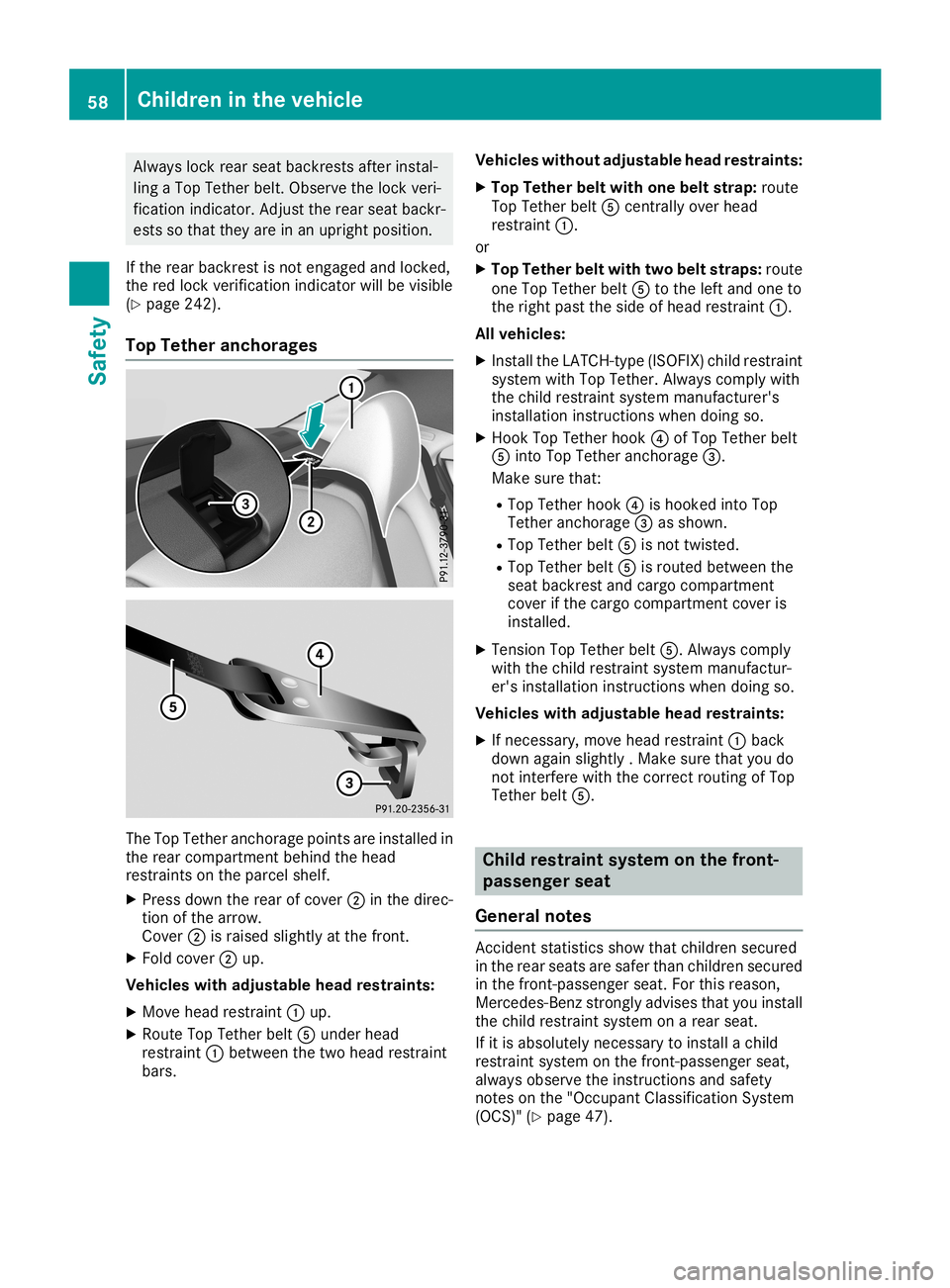
Alw
ayslo ck rea rsea tba ckres tsafte rins tal-
li ng aTop Tether belt. Obs ervethe lock ver i-
fica tionind icator. Adju stthe rearsea tba ckr-
ests sotha tthey arein an uprig ht positio n.
If the rearba ckres tis not engaged and locked ,
the red lock ver ificati onindicator willbe visible
(Y page 242 ).
Top Tethe ranc hora ges The
Top Tether anch oragepoints areins talledin
the rearcomp artment behind the head
res trai nts onthe parcel shelf.
X Pre ssdown the rearof cove r0044 inthe direc-
tio nof the arrow .
Co ver 0044israised slig htl yat the front.
X Fol dcove r0044 up.
Vehi cles with adjusta blehea dres train ts:
X Mov ehea dres trai nt0043 up.
X Ro ute Top Tether belt0083 und erhea d
res trai nt0043 betwe enthe two headres trai nt
ba rs. Vehi
cles withou tadjusta blehea dres train ts:
X Top Tethe rbe ltwi th onebe ltstrap: route
Top Tether belt0083 centra lly ove rhea d
res trai nt0043.
or X Top Tethe rbe ltwi th two beltstraps :rou te
one TopTether belt0083 tothe left and one to
the right past the side ofhea dres trai nt0043.
Al lve hic les:
X Insta llthe LATC H-typ e(ISO FIX) childres trai nt
sy stem with Top Tether .Alw ayscomp lywith
the childres trai ntsystem manuf actu rer's
ins tallatio nins truc tions when doing so.
X Hoo kTop Tether hook0085 ofTop Tether belt
0083 into TopTether anch orage0087.
Ma kesure tha t:
R Top Tether hook0085 ishoo ked into Top
Te ther anch orage0087 assho wn.
R Top Tether belt0083 isnot twisted .
R Top Tether belt0083 isrou ted betwe enthe
sea tba ckres tand cargocomp artment
cove rif the cargocomp artment coveris
ins talled.
X Te nsi on Top Tether belt0083. Alwayscomp ly
wi th the childres trai ntsystem manuf actu r-
er' sins tallatio nins truc tions when doing so.
Vehi cles with adjusta blehea dres train ts:
X Ifnece ssary,move headres trai nt0043 back
do wn again slig htl y.Ma kesure tha tyo udo
not interferewith the corr ectrouting ofTop
Te ther belt0083. Chi
ldres train tsys tem onthe fron t-
pass engerse at
Ge neral notes Accid
entstatistics showtha tchi ldren secured
in the rearsea tsaresa fer thanchi ldren secured
in the front-p asseng ersea t.For thisrea son,
Mer cedes-B enzstronglyad vis es tha tyo uins tall
the childres trai ntsystem onarea rsea t.
If it is ab sol ute lynece ssaryto ins talla chi ld
res trai ntsystem onthe front-p asseng ersea t,
al wa ysobser vethe instruc tions and safety
notes onthe "Occup antClas sifica tionSys tem
(OC S)"(Ypage 47) . 58
Ch
ildren inthe vehic leSafe ty
Page 62 of 330
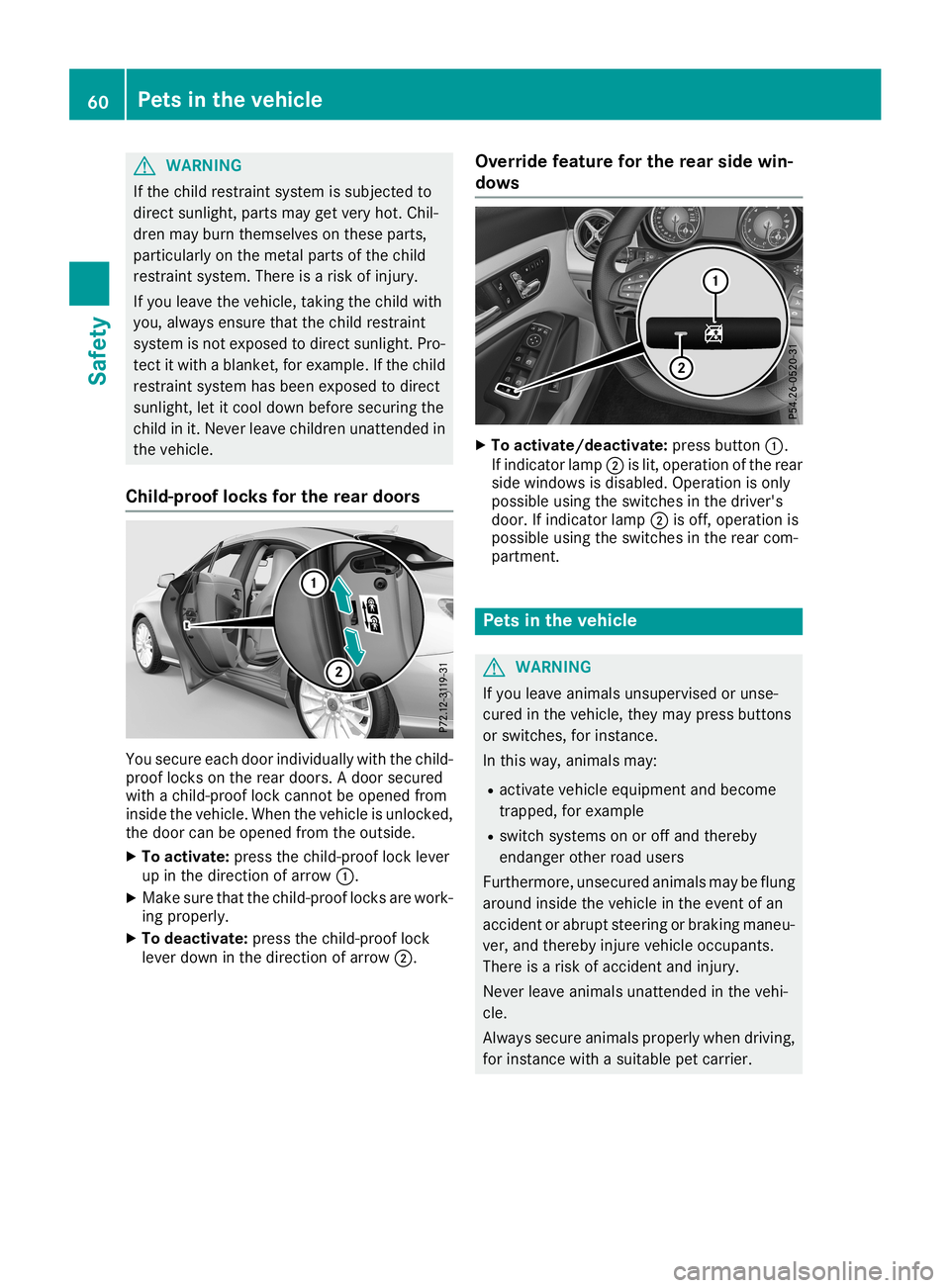
G
WARNING
If the child restrai ntsystem issub jected to
dire ctsunli ght,parts maygetvery hot.Chil-
dren mayburn themsel vesonthese parts,
particu larlyon the metal partsofthe child
restrai ntsystem. Thereisarisk ofinjury .
If you leavethe vehicl e,taking thechild with
you ,alw aysensure thatthechild restrai nt
system isnot expose dto dire ctsunli ght.Pro-
tect itwith abla nket, forexampl e.Ifthe child
restrai ntsystem hasbeen expose dto dire ct
sunli ght,letitcool downbefore securingthe
child init. Never leavechild renunattended in
the vehicl e.
Chil d-proof locksfor the rear doors You
secure eachdoorindivi duallywith thechild -
proof locksonthe rear doors. Adoor secure d
with achild -proof lockcannot beopened from
insid ethe vehicl e.When thevehicl eis unlocked ,
the door canbeopened fromtheoutsi de.
X To activate: pressthechild -proof locklever
up inthe direction ofarrow 0043.
X Make surethatthechild -proof locksarework-
ing prope rly.
X To deactiv ate:press thechild -proof lock
leve rdow nin the direction ofarrow 0044. Override
featureforthe rear side win-
dows X
To activate/ deactivate:press button 0043.
If indica torlamp 0044islit, opera tionofthe rear
side windo wsisdisa bled.Opera tionisonly
possi bleusing the switches inthe drive r's
door. Ifindica torlamp 0044isoff, opera tionis
possi bleusing the switches inthe rear com-
partment. Pets
inthe vehi cle G
WARNING
If you leaveanima lsunsu pervi sedorunse-
cured inthe vehicl e,they maypress buttons
or swi tches, forinstance.
In this way,anima lsmay :
R activa tevehicl eequ ipme ntand become
trappe d,for exampl e
R swi tch systems onoroff and thereby
endange rother roadusers
Furthermore ,unsecu redanima lsmay beflung
arou ndinsid ethe vehicl ein the event ofan
accide ntor abru ptsteering orbraki ngmaneu -
ver, and thereby injurevehicleoccupa nts.
There isarisk ofaccide ntand injury .
Never leaveanima lsunattended inthe vehi-
cle.
Alwa yssecure animalsprope rlywhen driving,
for instance withasui table petcarrie r. 60
Pets
inthe vehi cleSafety
Page 79 of 330
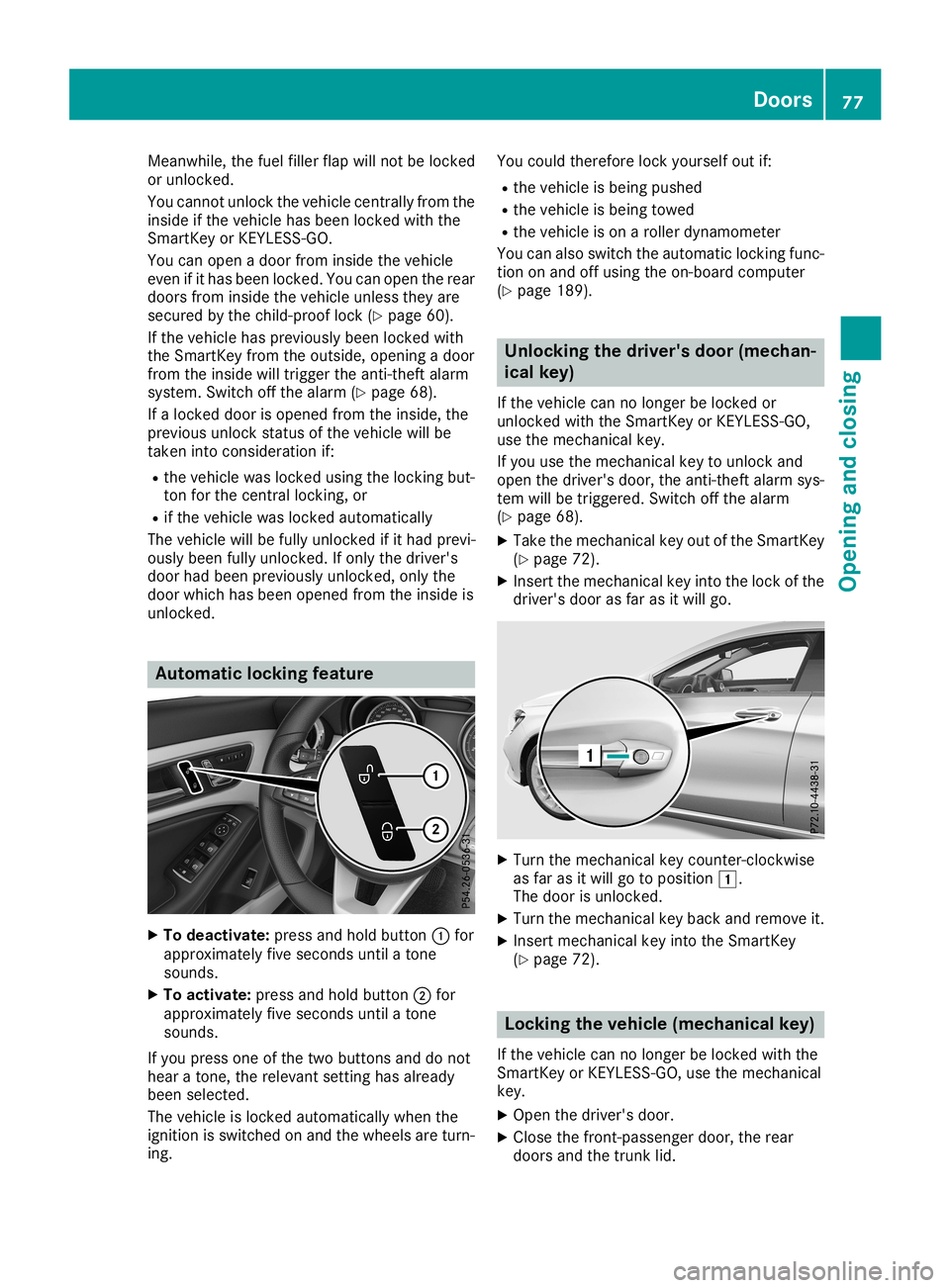
Meanwhile,
thefuel filler flapwillnotbelocked
or unlocked.
You cannot unlockthevehicle centrally from the
inside ifthe vehicle hasbeen locked withthe
SmartK eyorKEYLES S-GO.
You canopen adoor from inside thevehicle
even ifit has been locked. Youcanopen therear
doors frominside thevehicle unlesstheyare
secured bythe child-proof lock(Ypage 60).
If the vehicle haspreviously beenlocked with
the SmartK eyfrom theoutside, opening adoor
from theinside willtrigger theanti-t heftalarm
system. Switchoffthe alarm (Ypage 68).
If alocked doorisopened fromtheinside, the
previous unlockstatusofthe vehicle willbe
taken intoconsideration if:
R the vehicle waslocked usingthelocking but-
ton forthe cent rallocking, or
R ifthe vehicle waslocked automatically
The vehicle willbefully unlocked ifit had previ-
ously beenfullyunlocked. Ifonly thedriver's
door hadbeen previously unlocked,onlythe
door which hasbeen opened fromtheinside is
unlocked. Automat
iclockin gfeatur e X
To deactivate: pressandhold button 0043for
approximately fiveseconds untilatone
sounds.
X To activate: pressandhold button 0044for
approximately fiveseconds untilatone
sounds.
If you press oneofthe two buttons anddonot
hear atone, therelevant settinghas already
been selected.
The vehicle islocked automatically whenthe
ignition isswitched onand thewheels areturn-
ing. You
could therefore lockyourself outif:
R the vehicle isbeing pushed
R the vehicle isbeing towed
R the vehicle ison aroller dynamometer
You canalso switch theautomatic lockingfunc-
tion onand offusing theon-board computer
(Y page 189). Unloc
kingthedriver's door(mechan-
ical key)
If the vehicle cannolonger belocked or
unlocked withtheSmartK eyorKEYLES S-GO,
use themechanical key.
If you usethemechanical keytounlock and
open thedriver's door,theanti-t heftalarm sys-
tem willbetriggered. Switchoffthe alarm
(Y page 68).
X Take themechanical keyoutofthe SmartK ey
(Y page 72).
X Insert themechanical keyinto thelock ofthe
driver's doorasfar asitwill go. X
Turn themechanical keycounter- clockwise
as far asitwill gotoposition 0047.
The door isunlocked.
X Turn themechanical keyback andremove it.
X Insert mechanical keyinto theSmartK ey
(Y page 72). Locki
ngthe vehicle (mechanical key)
If the vehicle cannolonger belocked withthe
SmartK eyorKEYLES S-GO,usethemechanical
key.
X Open thedriver's door.
X Close thefront -passenger door,therear
doors andthetrunk lid. Doo
rs
77Opening andclosing Z